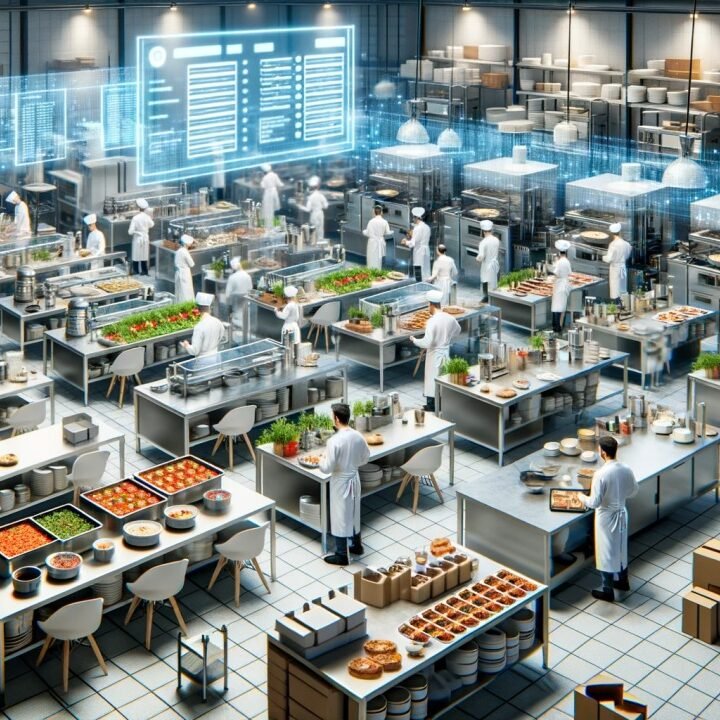In the wake of the COVID-19 pandemic, the restaurant industry has experienced a dramatic transformation, with the rise of ghost kitchens and virtual dining reshaping how we think about food and dining experiences. This innovative trend has emerged as a response to shifting consumer behaviors and market dynamics, offering a glimpse into the future of food service.
What Are Ghost Kitchens?
Ghost kitchens, also known as dark kitchens or cloud kitchens, are commercial kitchen spaces designed specifically for the preparation of food intended for delivery only. Unlike traditional restaurants, ghost kitchens operate without a physical storefront or dining area. Instead, they focus solely on fulfilling online orders, leveraging technology to streamline operations and maximize efficiency.
The concept of ghost kitchens is rooted in the idea of reducing overhead costs. By eliminating the need for a physical dining space, restaurants can invest more in kitchen equipment, ingredients, and delivery infrastructure. This model allows for a more flexible and scalable approach to food service, catering to the growing demand for convenient, on-demand meals.
The Virtual Dining Experience
Virtual dining takes the ghost kitchen concept a step further by creating new, often exclusive, dining experiences that exist only online. These virtual restaurants can operate out of existing ghost kitchens or traditional restaurant kitchens, offering unique menus that are marketed and sold exclusively through digital platforms.
The rise of virtual dining is driven by consumer demand for novel and diverse culinary experiences. By leveraging social media and food delivery apps, virtual restaurants can create buzz and attract a dedicated following without the constraints of a physical location. This model also allows for greater experimentation with menu items and pricing strategies, as virtual dining establishments can quickly adapt to changing trends and customer preferences.
Technological Innovations Driving the Trend
Several technological advancements have fueled the growth of ghost kitchens and virtual dining. Key among these is the development of sophisticated food delivery platforms and apps that streamline the ordering process and provide real-time tracking for customers. Additionally, data analytics tools enable ghost kitchens to optimize their operations, from inventory management to order fulfillment.
Automation technology is also playing a significant role in the efficiency of ghost kitchens. Automated cooking and prep equipment, such as robotic kitchen assistants and smart ovens, are increasingly being integrated into these spaces to speed up food preparation and ensure consistency.
Economic and Environmental Implications
The rise of ghost kitchens and virtual dining has several economic and environmental implications. Economically, this model can lower startup costs for new restaurant concepts and allow established brands to expand their reach without the need for additional physical locations. It also offers opportunities for entrepreneurs to test new concepts with lower financial risk.
Environmentally, the shift towards delivery-only models can reduce the carbon footprint associated with maintaining multiple restaurant locations. However, it also raises concerns about the increase in single-use packaging and the environmental impact of delivery vehicles. To address these issues, some ghost kitchens are exploring sustainable packaging solutions and optimizing delivery routes to minimize their environmental impact.
Current Trends and Innovations
As of late 2024, several trends and innovations are shaping the ghost kitchen and virtual dining landscape:
- Brand Partnerships and Collaborations: Many ghost kitchens are partnering with popular brands and chefs to offer exclusive menu items and limited-time promotions. These collaborations help attract attention and drive orders while leveraging the established reputation of well-known entities.
- Health and Wellness Focus: With a growing emphasis on health and wellness, many virtual dining concepts are offering menus that cater to dietary preferences such as vegan, gluten-free, and keto. This trend reflects a broader shift towards healthier eating habits and personalized nutrition.
- AI and Machine Learning: Advanced AI and machine learning algorithms are being used to predict customer preferences, optimize delivery routes, and manage inventory more efficiently. These technologies help ghost kitchens operate more smoothly and respond quickly to changing market demands.
- Global Expansion: While ghost kitchens and virtual dining have gained significant traction in urban centers, they are increasingly expanding to suburban and rural areas. This growth is driven by the increasing demand for convenient dining options beyond city limits.
- Enhanced Customer Engagement: Virtual restaurants are utilizing social media and influencer marketing to build brand loyalty and engage with customers. By creating engaging content and interactive promotions, these establishments are fostering a sense of community and connection with their audience.
Looking Ahead
The rise of ghost kitchens and virtual dining represents a significant shift in the food service industry. As consumer preferences continue to evolve, these models are likely to become even more prevalent, offering new opportunities for innovation and growth. Whether you’re a food enthusiast seeking the latest culinary trends or a restaurateur exploring new business models, the ghost kitchen and virtual dining phenomenon is one to watch closely in the coming years.
The evolution of dining is not just about convenience but also about reimagining the way we experience food. With technology and creativity driving the change, the future of dining promises to be as dynamic and diverse as the dishes being served.











